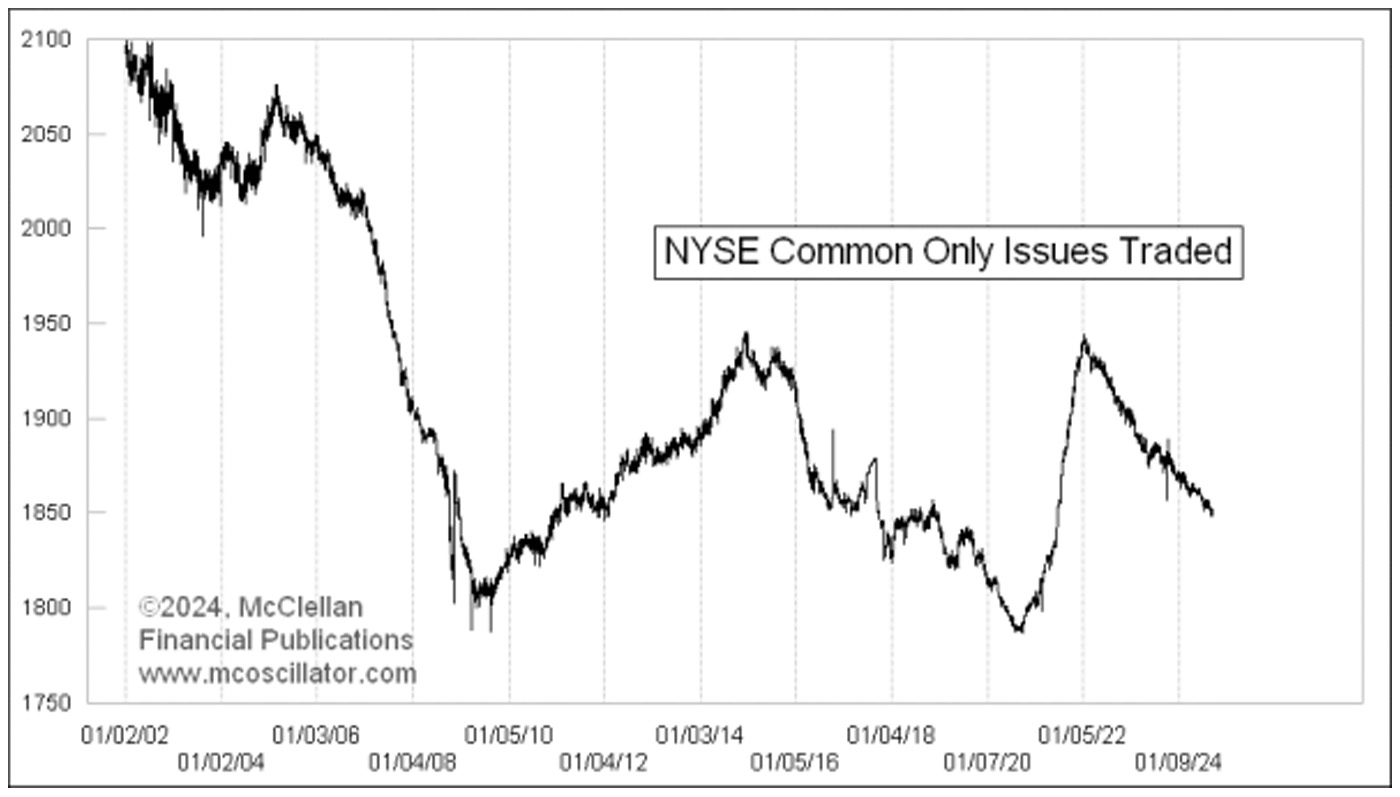The great unwinding of stock listings
The great unwinding of stock listings

The drop in the number of publicly traded U.S. companies continues. I last reported on this back in April. Since then, the losses in the NASDAQ have leveled off just a little bit, but the NYSE continues to lose listed issues.
FIGURE 1: THE NUMBER OF PUBLICLY TRADED U.S. COMPANIES CONTINUES TO DECLINE

Sources: Barron’s, McClellan Financial Publications
Several different factors have affected these totals over time, the most prominent being the availability of liquidity. In the growth years of the 1990s, when Alan Greenspan began to worry about “irrational exuberance” (1996), both markets saw rapid growth in the numbers of issues traded. The NASDAQ market’s total listings peaked in December 1996, more than three years before the final price top. And the NYSE’s listings peaked in early 1999, still well ahead of the internet bubble’s price peak.
![]() Related Article: The yield curve’s 15-month lag
Related Article: The yield curve’s 15-month lag
For several years in the 2000s, the electronic-only exchange now known as NYSE ARCA had its numbers included in the tally of NYSE issues. That changed when that exchange was spun off in June 2008.
The long decline in NASDAQ listings finally bottomed out in early 2013, shortly after QE3 started. That round of QE ended in 2014, but the growth of issues continued. It got a big boost in 2020 when the Fed and Congress conspired to throw a whole lot of money at the problems brought about by the COVID crash. Both the NYSE and NASDAQ peaked in their numbers of traded issues in 2022, just as that year’s bear market was about to start.
The 2022 bear market ended in October 2022, but the decline in the numbers of issues traded has continued. There are as many reasons for this as there are delisted companies. However, the best explanation, at least for the NASDAQ, is that the excesses from the COVID-related monetary expansion are still being unwound.
It gets harder to explain the continued losses of traded companies in the NYSE. Its total is now down to a level last seen in 1993. Interestingly, most of the losses have been in issues not categorized as “common stocks.” The total number of issues traded on the NYSE is down by more than 700 since the 2022 top, but only about 100 of those are common stocks.
Common stocks now make up 63% of the total NYSE list, up from the mid-50s percentage just a few years ago. The rest are what I like to call the “uncommon” issues, which include preferred stocks (16%), bond closed-end funds (CEFs) (6%), other CEFs (7%), and special purpose acquisition companies (SPACs) (7%).
FIGURE 2: NUMBER OF LISTED NYSE COMMON STOCKS DECLINES LESS THAN ‘UNCOMMON’

Source: McClellan Financial Publications
Overall, it is not bullish news that liquidity is leading to a reduction in the numbers of issues traded, though it has not affected the major indexes yet. It was a big problem in 2000, especially for the NASDAQ.
FIGURE 3: DOES A DECLINE IN TRADED ISSUES FORESHADOW A MARKET PEAK?

Source: McClellan Financial Publications
By the time the NASDAQ Composite Index peaked in March 2000, the number of NASDAQ traded issues had already fallen by 17%. The foundations were crumbling for a long time before the final top came.
As of September 2024, the number of NASDAQ traded issues is down 16% from the 2022 high. So far, the major averages show no sign of liquidity problems. Neither do the breadth statistics, with the NYSE A-D Line at a new all-time high. I believe that the drying up of all the COVID money will matter at some point, though I cannot demonstrate that we are at that point just yet. But we are on the way.
The opinions expressed in this article are those of the author and the sources cited and do not necessarily represent the views of Proactive Advisor Magazine. This material is presented for educational purposes only.
This is an edited version of an article that first appeared at McClellan Financial Publications on Sept. 26, 2024.
 Tom McClellan is the editor of The McClellan Market Report newsletter and its companion, Daily Edition. He started that publication in 1995 with his father Sherman McClellan, the co-creator of the McClellan Oscillator, and Tom still has the privilege of working with his father. Tom is a 1982 graduate of West Point, and served 11 years as an Army helicopter pilot before moving to his current career. Tom was named by Timer Digest as the #1 Long-Term Stock Market Timer for both 2011 and 2012. mcoscillator.com
Tom McClellan is the editor of The McClellan Market Report newsletter and its companion, Daily Edition. He started that publication in 1995 with his father Sherman McClellan, the co-creator of the McClellan Oscillator, and Tom still has the privilege of working with his father. Tom is a 1982 graduate of West Point, and served 11 years as an Army helicopter pilot before moving to his current career. Tom was named by Timer Digest as the #1 Long-Term Stock Market Timer for both 2011 and 2012. mcoscillator.com
RECENT POSTS








